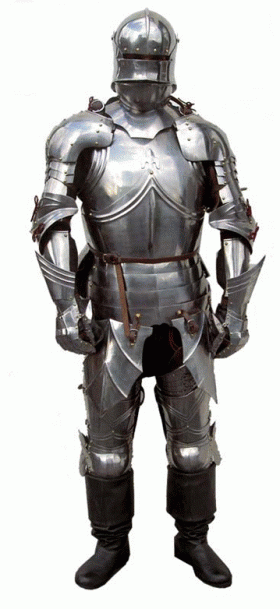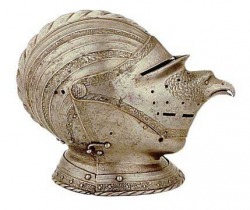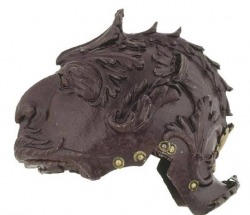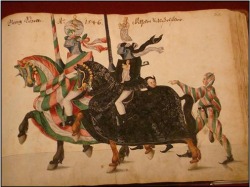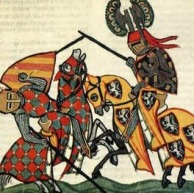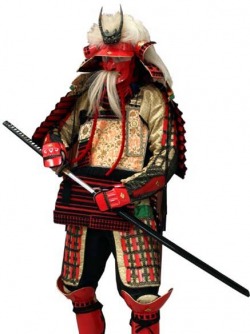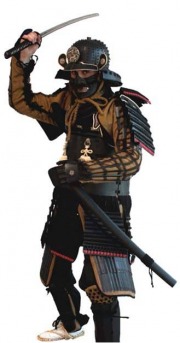Chivalloot™© By Ramsey Ronalds
100% FUN 100% FREE
100% FUN 100% FREE
INTRODUCTION
When we think of the medieval period we sometimes associate it with Knights, well...your right! Medieval knights played a significant role in the society of the middle-ages. Knights were to obey a king and fight for him, in return, the King gave the knight land, castles and servants. It was a good deal, but alot of these knights died in battle. The following page will give images of battle armour and beautifully crafted armour as well. Yes, thats right, towards the end of the 15th century the idea of armoured men became old, as gunpowder introduced from china gave way to nasty machines called cannons, which were no match for the steel plates. Knights died away and became noble land owners. But the idea of armour went on, and specially made armour was made for parades and tornaments, as you will see below.
The photo of the Knight above is a classic example of what a Knight would look like before battle in the middle-ages. Starting from the top, the helmet covers the whole face, while the Gorget, (neck armour) connects with the upper half.The pauldrons (shoulder pieces) are part of the breast plate which are attached to the leggings. This knight is wearing boots, although during the 14th century special knight boots were called sabatons. Their was also a cod-piece to protect his baby making organs, it didnt prove very useful if you had a pike stuck up their. A squire would dress this knight and it would take up to an hour! Where were the good old days when they simply pulled chain mail over their heads?
PUCKER SUIT
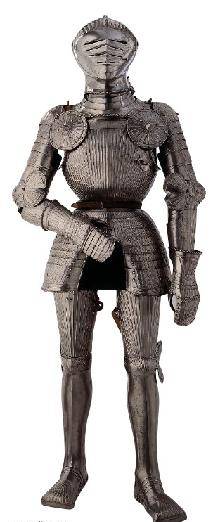
This suit of armour was made in Germany around 1520. This style of armour is 'Maximilian' after the German Emperor. It's design is similar to pieces of Italian armour fused with German armour. The decorations are the 'flute' style. It went out of use around 1530. This suit is made up of several surving pieces of this type of armour.
The visor is in the 'Bellows' style, so called because of its shape. The round disks were NOT originally to protect parts of the chest, but to protect the armpits from face foward attacks. The knee cap, or 'wing' protected the knight from side cuts.
The visor is in the 'Bellows' style, so called because of its shape. The round disks were NOT originally to protect parts of the chest, but to protect the armpits from face foward attacks. The knee cap, or 'wing' protected the knight from side cuts.
CUIRASSIER
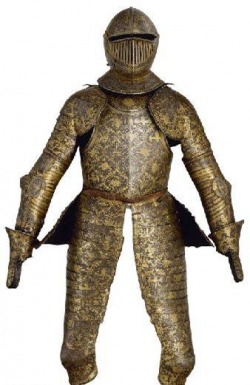
This exceptionally beuatiful suit of armour is called a Cuirassier. The use of pikemen and soldiers with guns meant Knights could no longer use lances to charge at the enemy. To protect themselves from these kind of attacks, the metal used to make the armour was made thicker. Since the armour became heavier, the lower leg defences were removed and replaced with standard riding boots. This suit of armour was made in Italy in the 17th century is finely etched, while other suit armours like this were crudely made.
The leggings now have a special name called a Tasset, this tasset is a long type. The tasset also has a detachable knee-piece on the end. The helmet is a full faced type, this one does not have a Gorget.
The leggings now have a special name called a Tasset, this tasset is a long type. The tasset also has a detachable knee-piece on the end. The helmet is a full faced type, this one does not have a Gorget.
The two helmets, (above and below) are examples of PARADE HELMETS. Parade Helmets were helmets used especially for tournaments. These ones were worn while parading up and and down the eager crowds just before starting the fight. A lady would also look at each contestant before the fight. If she thought a knight had not been chivalrous, then he was stripped of his title and disqualified. A big shame.
ARMOUR FOR BATTLE AND ARMOUR FOR FUN
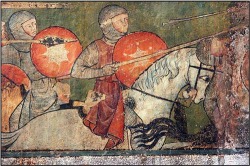
The picture to the left is a primary source showing the appearence of early knights in battle. While the pictures below shows what knights looked like in jousts and tournaments. The armour for a tournament is more splendid than the armour for battle. This is because armour worn for battle needed to be more protective than good looking, they wern't fighting to impress anybody, they were fighting for their King and country and would do it in any means nessecary.
On the other hand, the armour below is majestic and royal. This is because they are boasting about their strength and royalty. The knights below wear tunics over their armour and their horse bearing their Family Crest. A Family Crest or Coat of Arms was a way of showing which family you came from. Only nobles could have one and it was worn on their armour, shields, flags ect. Having your coat of arms taken away from you was a big disgrace, but it rarely happened, becuase the King needed as many Knights to fight for him as possible.
The fight below is being fought with Lances, this tells us it is a joust. A joust was a form of game where two knights charged at each other. One version is to knock the other knight off his horse and win him, while later versions were trying to shatter the lance against the oppononents shield. This was a way for Knights to show their strength and impress the ladies who were always on the look out for a good Knight to have (if you get what i mean).
On the other hand, the armour below is majestic and royal. This is because they are boasting about their strength and royalty. The knights below wear tunics over their armour and their horse bearing their Family Crest. A Family Crest or Coat of Arms was a way of showing which family you came from. Only nobles could have one and it was worn on their armour, shields, flags ect. Having your coat of arms taken away from you was a big disgrace, but it rarely happened, becuase the King needed as many Knights to fight for him as possible.
The fight below is being fought with Lances, this tells us it is a joust. A joust was a form of game where two knights charged at each other. One version is to knock the other knight off his horse and win him, while later versions were trying to shatter the lance against the oppononents shield. This was a way for Knights to show their strength and impress the ladies who were always on the look out for a good Knight to have (if you get what i mean).
KNIGHTS OF THE RISING SUN
Europe wasn't the only continent to have Knights. Japan also had knights, these knights were called the Samurai. The Samurai were a special elite of soldiers who were subject to a Shogun, the ultimate military leader. Peasants and the rest of society were subject to the Samurai, just like Knights back in Europe. Samurai armour was unique, and made to scare off enemies. Early armour was made when the Samurai fought on foot. Later on they began riding horses and using bows as well as a Katana, (main Samurai sword) and spear. Below are examples or Samurai Armour.
The two pictures above show different types of Samurai armour. The one on the upper left is in the TAKEDA SHINGEN style, while the one on the upper right is in the DRAGON style. Both look different just by looking at them. Both helmets look different, the design of the chest plates are different and the material used looks different. Overall Samurai armour was soaked in a special chemical to prevent it rusting since Japan has a tropical climate.
